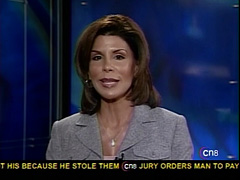Four More Fines for Fake News: FCC Says VNRs Are "Valuable Consideration"
 CN8's Janet ZappalaThe Federal Communications Commission (FCC) has announced four more fines against Comcast, for its cable channel CN8 having aired multiple video news releases (VNRs) without disclosure. But the bigger story is the FCC's reasoning behind the fines.
CN8's Janet ZappalaThe Federal Communications Commission (FCC) has announced four more fines against Comcast, for its cable channel CN8 having aired multiple video news releases (VNRs) without disclosure. But the bigger story is the FCC's reasoning behind the fines.
In the new notice, the FCC states that "the VNR itself was the 'valuable consideration' provided to CN8." This is the first time that the agency has equated VNRs with "valuable consideration," an argument that the Center for Media and Democracy (CMD) has long advanced.
What does this mean and why is it a big deal? Basically, it shoots out of the water a favorite argument of broadcasters and their friends in the PR industry: that disclosure is only required when stations are paid to air VNRs, or when VNRs deal with controversial or political issues.
The FCC began to chip away at that argument last week, when it fined Comcast for airing a sleep remedy VNR. At the time, the agency explained that the VNR footage aired by CN8 contained "extensive images and mentions of the product." That left me -- and probably hundreds of broadcasters and cablecasters across the United States -- wondering just how promotional was too promotional, in the FCC's eyes.
But the FCC now seems to be strengthening their VNR disclosure standards. The "valuable consideration" language hearkens back to early radio payola scandals, when record companies gave stations money or valuable gifts in return for airing their labels' artists.
Given how expensive it is to produce, film, edit and script a real television news report, CMD estimates that TV newsrooms save thousands of dollars for each minute that they air VNR footage instead of real news. Therefore, as the director of George Washington University's journalism program stated, "stations that accept outside video are in effect accepting an in-kind contribution from that source."
In other words, every VNR is a "valuable consideration" to the newsroom that receives it, and its source must be disclosed to news viewers. Given that CMD's two reports named 111 TV stations, the FCC will presumably be issuing many more fines. (All five fines announced to date stem from the CMD report "Still Not the News," and a formal complaint filed by CMD and Free Press. Complaints against the more than 100 other stations that CMD documented airing fake news without disclosure, in the "Still Not the News" and "Fake TV News" reports, are still pending.)
The FCC also faults the newly-fined VNRs for their promotional content, saying it goes far beyond the acceptable "fleeting or transient references to products or brand names." Watch the VNRs at the following links, and see the shilling for yourself:
- General Mills "Don't Be a Couch Potato" VNR, which promoted Wheaties brand cereal. After the segment, CN8 consumer reporter Janet Zappala gave viewers the address for the Wheaties website. WUHF-31 in Rochester, NY also aired this VNR. A WUHF anchor even asked news viewers, while holding a box of the cereal, "Did you eat your Wheaties today?"
- An Allstate VNR, which promoted life insurance. Zappala helpfully read straight from the VNR's script, telling viewers "life insurance is like money in the bank." The FCC noted that the Allstate representative interviewed in the segment was "seated in front of the Allstate logo."
- General Mills "Bisquick 75th Anniversary" VNR. The CN8 segment, once again introduced and narrated by Zappala, "almost continually featured the Bisquick logo," as CMD's "Still Not the News" report noted.
- Trend Micro Software's VNR, which promoted their computer security software. In this case, the original VNR ended with a verbal and on-screen mention of Trend Micro as the source of the video. CN8 edited out this built-in disclosure before airing it, as yet another Zappala "consumer report."
The vast majority of VNRs are funded by corporations to promote their products or public image. That's why, back in March 2005, the head of the major PR firm Medialink Worldwide reacted to the uproar over Bush administration VNRs by telling his colleagues:
[L]et's remember this debate, from everything I've seen, read, heard, and talked to, is purely the government. It has -- I don't hear anybody issuing a healing cry over the stuff that we do day-in and day-out; it's really government. And I'm glad the story is kind of focused there, because I would hate to see it broaden, and it seems very focused.
And that's why, if the FCC applies its recently-articulated VNR disclosure standards, news viewers' right to know will be protected at least 95 percent of the time. That's a vast improvement over the current vast wasteland of fake TV news.





Comments
Response from former CN8 reporter Janet Zappala
In April 2009, former CN8 reporter Janet Zappala contacted the Center for Media and Democracy to state that: "I am an award-winning journalist who has always taken the utmost pride in my work. ... [At CN8] at the time all of this transpired, we had a very limited staff with very limited resources and were trying to do the best with what little we had. ... We were not set up at the time with our own station website; therefore the only way we could help our viewers find more information on a given topic was to give the only website available. I never endorsed any products or companies."
The Dog Ate Ms. Zappala's Homework
Sorry but this excuse doesn't make it. One big reason that fake news has replaced real news is that the supposedly real, professional journalists are not outraged by it. Get out there and fight for real journalism, Janet, don't just make excuses. Either you are a journalist, or a shill, and there should be little middle ground.
I don't like fake news more than anyone else,
but I can't help observing how easy it is to order other people from the sidelines to get out there and fight. I'm just glad there's still anyone at all who does.
FCC Issues First VNR Fine. More to Come?
On Monday, the FCC issued a $4,000 fine to a cable operator for the use of a so-called Video News Release, or VNR, in a news segment focusing on consumer issues. The facts in this case are very similar to the facts in dozens of other inquiries involving broadcast television stations that remain pending before the Commission, and this decision could very well signal the beginning of a number of forfeitures aimed at cracking down on the (until recently) common practice of using video material provided for free by third-parties without providing attribution or a sponsorship identification. The decision was issued by the Enforcement Bureau and not the full Commission, and goes to lengths to explain that the sponsorship rules apply to cablecasting material aired by cable operators, and that the use of even a free video (i.e. with no consideration promised or paid to the cable operator or broadcaster) can require a sponsorship ID, even if no political or controversial issue is involved.
In this case, a cable network aired potions of video from a VNR produced on behalf of a product called "Nelson's Rescue Sleep." No consideration was given or promised to the cable operator, but the VNR was provided to the cable operator for free. The sponsorship ID rules typically come into play when money, services, or other valuable consideration is given in exchange for airing the particular material. Normally, the phrase "services or other valuable consideration" does not typically include services or property furnished without charge or at a nominal fee, such as the VNR. In this case, however, the FCC concluded that the video was furnished in consideration for the product being identified to a degree greater than what was reasonably related to the use of the product or service in the broadcast. The VNR was included in a news segment about non-prescription sleep aids, but the segment did not contain any other sleep-aid products. And (because it was a VNR for the product itself) the segment dwelled on and discussed at length the underlying product "Nelson's Rescue Sleep." Citing to a 44-year old FCC Public Notice that provided guidance to broadcasters in the early 1960s about the sponsorship ID rules, the FCC found that the use of the VNR in this situation obviated the exception for free material and that a sponsorship identification should have been included. A copy of the FCC's decision is available here.
The FCC's forfeiture order was adopted exactly one year to the day that the material was aired by the cable operator, and thus, seems to have been issued now so as to avoid the possibility that the statute of limitations prevent the Commission from issuing a fine. Although this is the first such VNR fine against either a cable operator or television broadcaster, it seems likely that more such decisions will be forthcoming. Indeed, Commissioner Adelstein, who has championed this novel interpretation of the sponsorship identification rules, was quick to issue a statement applauding the Enforcement Bureau for its decision. Given that the decision seems to cross into the territory of a cable operator's or broadcaster's editorial and journalistic discretion protected by the First Amendment, one can imagine that the cable operator (and any broadcasters fined in the future) will attack vigorously the FCC's interpretation of its sponsorship ID rules with respect to VNRs.
UPDATE: On Thursday (September 27, 2007), the Commission issued a further decision involving the same cable operator, fining the operator an additional $16,000 for four more VNR incidents similar to the one discussed above. In each instance, the cable operator included video that was received for free in a program aired on the system without attribution or a sponsorship identification. The Commission concluded that the free video clips contained extensive images, discussion, and mention of the particular product, which triggered the sponsorship ID rules. A copy of that decision is available here.
In a related item, two key members of Congress released a letter today praising Chairman Martin's recent comments regarding product placement in television and encouraging him to commence a proceeding looking into the practice. According to Congressmen Ed Markey and Henry Waxman, the use of product placement on television is on the rise as stations try to combat the "Tivo effect" of viewers by-passing traditional commercials. A copy of the letter is available here, and it will be interesting to see how the Commission approaches the issue.
_____________________
Bebes
What a delicious paradox!
To viewers who watch newscasts to hear the news, not to mention activists concerned with ensuring that news programs serve up real news to viewers, these VNRs are garbage. But for the purpose of fining stations for airing them in news shows without disclosure, they're "valuable consideration."
Oh well, whatever works. :-)